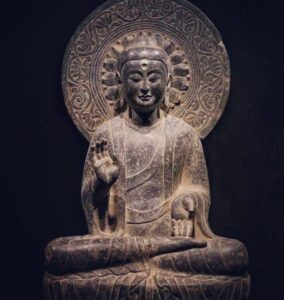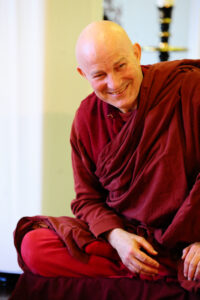Venerable Tomas Dhammadipa on Anapana Sati (Breath) Meditation
A reflection on practice by Venerable Tomas Dhammadipa
Knowledge of the Buddhist way should be applied in practice & verified first hand through direct experience. One should make a great vow to tread the way & realize the Dharma for the benefit of all sentient beings.
This is the essence of Buddhist Wisdom… In order to attain Wisdom, we have to practice: 1) Samatha – meditation for the Appeasement of  the mind. 2) Vipassana – Insight meditation. According to Buddhist tradition, the Buddha himself used Anapana Sati meditation to attain Enlightenment. This is the most respected meditation in all traditions, both the North & the South. Why? The Buddha himself told, “See it yourself. Do not accept just because I say so.”
the mind. 2) Vipassana – Insight meditation. According to Buddhist tradition, the Buddha himself used Anapana Sati meditation to attain Enlightenment. This is the most respected meditation in all traditions, both the North & the South. Why? The Buddha himself told, “See it yourself. Do not accept just because I say so.”
The phenomenon of Breath, whether we are aware of it or not, is the basis of living. If we don’t breathe, we don’t live. Both our Mind & Body participates in it till our Life lasts. The process of breathing is dependent on our Body on the one hand & on the other, on our Mind. “Breath” belongs to the element of “Rupa” (Body), but cannot function without the “Nama” (Mind). When the function of the Mind ceases, the Breath will cease too.
The “In – Out Breathing” reflects the condition of the Mind & the Body and its mutual inter-relationship. This is the Buddhist Wisdom. For example, if we use the Body & Mind with effort, it affects the condition of our Breath & vice versa. We have to understand this. In Buddhist scriptures our human body is compared with the “billows” used by goldsmiths. The hand which operates the billows, is our Mind. If we use the billows with much effort, our Breath will be fast. If we use the billows with little effort, our Breath will be slow. Our Breath will depend on our effort.
 If you have strong emotions, it will reflect on the quality of your Breath, and you will use much effort for perceptions of your Mind. When you cool down, your feelings, perceptions & Breath changes. What we have to strive for is “Appeased Breath,” especially when we face difficulties in life. So practice this meditation to achieve an appeased mind. Then you will be able to cope with any difficulties/defilements in daily life, with the “Mindfulness of Breath.”
If you have strong emotions, it will reflect on the quality of your Breath, and you will use much effort for perceptions of your Mind. When you cool down, your feelings, perceptions & Breath changes. What we have to strive for is “Appeased Breath,” especially when we face difficulties in life. So practice this meditation to achieve an appeased mind. Then you will be able to cope with any difficulties/defilements in daily life, with the “Mindfulness of Breath.”
When the Mind is appeased & calm, the Breath will be slow. When the Mind is agitated, the Breath will be fast. Study of the “In – Out Breath” is connected with Wisdom. Watch the Breath with Wisdom. The Breath is a direct reflection of how you use your Mind & Body.
The importance of this method of being “Mindful of the Breath” is that the Breath informs you from birth to death, about the “Conditions of your Mind & Body.” This is the Wisdom of the Breath. The Breath is “Mind created Reality” (an object created by the Mind) So, if our Mind does not exist, our Breath does not exist either. To understand Breath, you have to understand this – that it is a “Mind-Created Reality.”
A rare gem in contemporary Buddhism, Venerable Tomas Dhammadipa was born in Czechoslovakia, where he studied Chinese literature & philosophy. He studied under renowned contemporary masters of Buddhism in Japan, Sri Lanka & Burma, and received ordination in both Theravada & Mahayana traditions. One of his principal teachers was Burmese meditation master Pa Auk Sayadaw, who recognized him as his first Western disciple qualified to teach meditation.
Above excerpted from transcripts of Dhamma talk given by Ven Dhammadipa in Toronto in 2006. See transcript of full talk at: https://ia904509.us.archive.org/16/items/2006anapanasatimeditationstoronto_txt/2006%20Anapanasati%20meditations%20(Toronto).pdf
See more about Venerable Tomas Dhammadipa
